How Much Does a Wooden Dining Room Table Cost
By Bailiegh Basham · July 13, 2022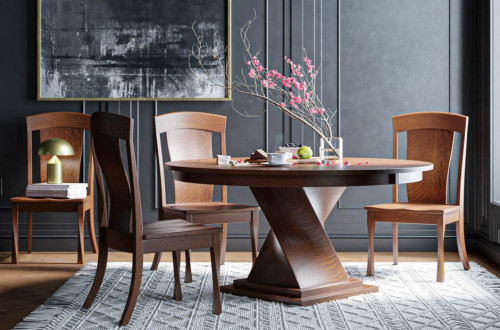
Typically, a quality, solid wood dining room table will cost anywhere from $1,200 to $10,000 with most priced between $2,000 to $6,000. Quite a range, right? And what’s the difference between that $1,200 table and the $10,000, anyhow?
To best explain the range, we show two tables below, starting with the Tall Timbers Extendable Dining Table (pictured in white oak). Due to its intricate base design, and unique ability to extend from 78" to 246" in length, its price tag will be between $5,500 and $10,185 (depending on the chosen hardwood, initial dimensions, and optional leaf additions). Comparatively, the smaller and simpler Myrtle Beach Dining Table (shown in brown maple) has an asking price between $1,600 and $2,600 (depending on the selected size, hardwood, and optional leaves).
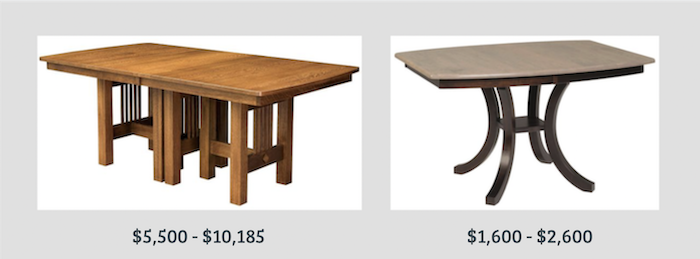
Our point? A number of factors influence the asking price of a dining room table, all of which can be categorized in one of two ways: the cost of the resources and the amount of labor that goes into production.
Countryside Amish Furniture put together this comprehensive guide to help answer how much does a table cost and provide guidance for finding the right dining furniture for your budget.
The Materials or Wood
Arguably the biggest determining factor in a table’s price is the quality of the materials. For the sake of today’s article, we’ll assume you’re not interested in cheaper, flimsy plastics or laminents. So, instead, we’ll break down some of the more common mid-to-upper-scale materials.
- Glass - Glass tables have many benefits, from their easy maintenance to their inherent airiness. And you can add lower prices to that list! Some cons include its vulnerability to major bumps and can cut or scratch.
-
Marble - Be prepared to roll out the big bucks for a marble table! This eye-catching material will make you feel (and spend) like royalty. It’s available in numerous colors and patterns that lend themselves to many different decor themes. However, marble tables are potentially the hardest to maintain long-term due to easy scratching and staining.
- Solid wood - The most popular textile for dining room tables, this encompasses a broad range of species that come with diverse price points. Popular North American hardwoods include:
- Solid oak - You may be surprised to learn that “oak” is actually a fairly broad category that encompasses multiple types of trees. However, most people seek out red or white oak, the latter being the more expensive due to its robustness and natural resistance against moisture, warping, and dents.
- Brown Maple - This hardwood has earned its fair share of fans due to its distinctive streaking and dark undertones. Though more expensive than red oak, a brown maple dining room table will typically cost less than those made in other woods.
- Elm - Another hardwood that requires a lesser asking price, elm has a unique grain and warm tints that enhance a table’s natural appeal.
- Cherry - This is a wood that never goes out of style, thanks to its warmish undertones. It’s slightly more costly than red oak and brown maple, and generally is on par with white oak’s pricing.
- Hickory - More expensive than any other wood previously mentioned, hickory is celebrated for its impressive strength, warm tints, and striped grain.
- Walnut - This wood exudes luxury from both its appearance and price tag. Its straight grain and coloring differentiate it from some of the other woods listed.
With its undying popularity, it’s no surprise that wood has its fair share of knockoff imitators. Some are better than others (check out Wood Veneer vs. Solid Wood Furniture), and they almost always have a reduced price tag. However, because the quality is subpar, most wood alternatives don’t offer the same long-term investment as a solid wood dining table.
The Size and Thickness of the Dining Room Table
It should be no surprise that the dimensions of the dining room table will influence its price. After all, not only does a larger table require more materials, but it may also be more time-consuming to construct and arduous to transport. Keep in mind both the base size and those of the leaf extensions when factoring whether a dining room table’s price is worth it.
One similar consideration many shoppers don’t think about is the thickness of the tabletop. However, this is an important factor in the price as well (the thicker the top, the higher the cost).
The Style of the Dining Room Table
Much like fashionable dresses, dining room tables come in surprisingly diverse styles. Just like you wouldn’t expect a casual frock and a bridal gown to have the same price tag, the design of the table itself impacts the cost. Though there are plenty of special cases that break “the rules,” you can expect certain table types to cost more than others.
Dining Room Tables With Typically Lower Costs
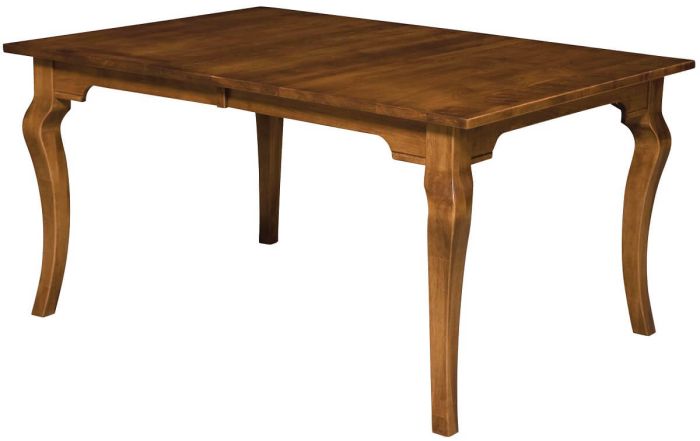 The table’s lesser cost doesn’t correlate with its overall quality. Rather, these styles tend to be smaller, require less materials, and be simpler in nature.
The table’s lesser cost doesn’t correlate with its overall quality. Rather, these styles tend to be smaller, require less materials, and be simpler in nature.
- Leg tables - Much like the name implies, these tables are best described as a wooden surface sitting atop four legs. Their simplicity lends itself to diverse decor themes, and they rarely clash or steal the spotlight.
- Single pedestal tables - While leg tables tend to be rectangular (with plenty of exceptions), single pedestal tables are normally round or square. The design of the furniture means that there’s a limit to the dimensions of the table top, making this style preferable for smaller sizes.
Dining Room Tables With Typically Higher Costs
These designs tend to be larger and heavier, or potentially require more labor due to the intricate nature of the assembly, all of which will reflect in the table’s cost.
- Trestle dining tables - Look underneath the table to find the defining characteristic of this particular style. Two decorative ends connect with a supportive beam for a table that is both eye-catching and undeniably stable, well worth the cost. These can come in the same smaller dimensions as other tables; however, because the intricate woodworking of the ends makes it harder to seat guests at these particular spots due to reduced leg room, they are typically sold in larger sizes.
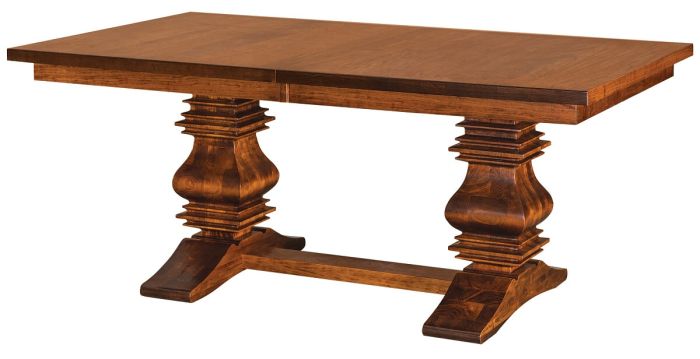 Double pedestal dining tables - The pair of pedestals exist for one reason: to support the added length and weight that would be too much for a single pedestal. For this reason, these tables tend to be larger (and the second pedestal requires extra materials), resulting in an elevated price tag.
Double pedestal dining tables - The pair of pedestals exist for one reason: to support the added length and weight that would be too much for a single pedestal. For this reason, these tables tend to be larger (and the second pedestal requires extra materials), resulting in an elevated price tag.
- Butterfly leaf tables - As you can read about in our designated blog post, butterfly leaf tables offer a little something extra when compared to their peers. While a lot of other tables have leaves you can add on for extra dining space, this type stores the bonus pieces within itself for extra convenience. Opening up the table to access the leaves requires a highly specialized mechanism that adds to the cost of the table.
The Details and Depth of Decorations
Sometimes a table is just a table. Other times, it’s a work of art. If you want the latter, you should expect to pay extra. Stylish wood table details like fluted or cabriole silhouettes, as well as carved aprons, and intricate trestles take extra time to create, as well as an elevated level of craftsmanship.
Another consideration is whether the piece features a specialty finish, whether that be high-end paint, a multi-step glaze, or the step of distressing the wood for added personality.
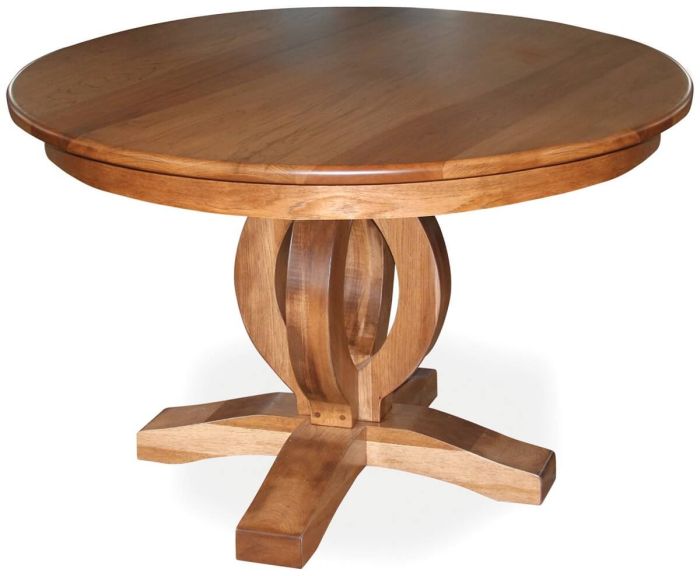
The Quality of the Dining Room Table Build
Much like the previously mentioned wedding dress, who builds the dining room table will greatly impact its cost. If the table is mass produced in overseas factories with questionable working conditions, the price tag may be lower. On the other end of the spectrum, you have American woodworkers who make each piece to order, calling upon years of training. The quality of the produced dining table will be significantly higher, and you should expect a price tag that reflects this.
The experience and standards of the builder impact the dining room table’s cost in other ways you may not expect. A cheaper price tag may mean the company used cheap materials and rapid practices for joining pieces (with staples and glue versus advanced techniques). They may have also used subpar finishes and stains.
Long story short, if a dining room table’s price is too good to be true, do your homework to find out why. In an effort to save money in the short term, you might ultimately end up with a table that will last months rather than a lifetime.
Find Dining Room Tables for a Variety of Prices at Countryside Amish Furniture
Countryside Amish Furniture carries hundreds of dining room tables ranging from simple Shaker designs to live edge pieces to meticulously carved masterpieces. In turn, our tables cover a broad range of price points. We let you customize the size, the type of wood, and add-on features to further help you in your quest for the right table for the right budget.
As varied as our furniture may be, it all shares two things in common: the utilization of solid, North American hardwood, and that it's handcrafted by experienced Amish artisans. We welcome you to explore our designs, place your order, and ask us any questions about the pricing or otherwise using our chat function.

